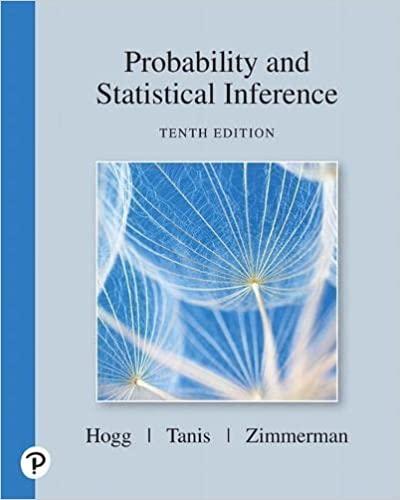Question
Rats in a Maze A researcher has collected some data on the amount of time in seconds (to the nearest 0.1 second) that it took
Rats in a Maze A researcher has collected some data on the amount of time in seconds (to the nearest 0.1 second) that it took 36 trained rats to run through a maze. The data is shown below arranged in a frequency distribution of grouped scores.
Class Interval Frequency 7.6-7.9 3 7.2-7.5 1 6.8-7.1 6 6.4-6.7 6 6.0-6.3 3 5.6-5.9 4 5.2-5.5 5 4.8-5.1 4 4.4-4.7 1 4.0-4.3 3 10. Refer to Rats in a Maze. The real limits of the interval 6.4-6.7 are _________.
a. 6.3-6.8
b. 6.4-6.7
c. 6.35-6.75
d. 6.45-6.75
e. 6.395-6.405
11. Refer to Rats in a Maze. The relative frequency for the interval 5.2-5.5 is _________.
a. 0.03
b. 0.14
c. 0.11
d. 13
e. 3.05
12. Refer to Rats in a Maze. The cumulative frequency for the interval 5.6-5.9 is _________.
a. 17
b. 13
c. 20
d. 23
e. 28
13. Refer to Rats in a Maze. The cumulative percentage for the interval 5.2-5.5 is _________.
a. 77.78%
b. 47.22%
c. 22.22%
d. 36.11%
e. 13.89%
14. Refer to Rats in a Maze: Draw the frequency histogram for this data. (4 marks) Psyc 2F23 section 02/03 name __________________ id _________ page 5 *15. Consider the following stem and leaf diagram 4|0 1 1 2 2 3 4 4 4 4|5 5 6 6 6 6 7 7 7 8 9 9 5|2 2 2 3 3 4 4 5|5 7 8 9 9 6|0 1 2 3 6|5 9 7|0 1 7|6 What is the median score? _______ (1 mark) What is the range? _________ (1 mark) What one or two words best describe this distribution? (1 mark) ___________________ What is the lower real limit of the highest interval? (1 mark) _________ How would a histogram of this data differ from what is presented? (ONLY use space provided) (1 mark)
Step by Step Solution
There are 3 Steps involved in it
Step: 1

Get Instant Access to Expert-Tailored Solutions
See step-by-step solutions with expert insights and AI powered tools for academic success
Step: 2

Step: 3

Ace Your Homework with AI
Get the answers you need in no time with our AI-driven, step-by-step assistance
Get Started


